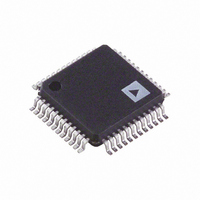ADAU1592ASVZ Analog Devices Inc, ADAU1592ASVZ Datasheet - Page 17

ADAU1592ASVZ
Manufacturer Part Number
ADAU1592ASVZ
Description
IC AMP AUDIO PWR 24W STER 48TQFP
Manufacturer
Analog Devices Inc
Type
Class Dr
Datasheet
1.ADAU1592ACPZ.pdf
(24 pages)
Specifications of ADAU1592ASVZ
Output Type
2-Channel (Stereo)
Max Output Power X Channels @ Load
24W x 2 @ 4 Ohm
Voltage - Supply
9 V ~ 18 V
Features
Depop, Mute, Short-Circuit and Thermal Protection, Standby
Mounting Type
Surface Mount
Package / Case
48-TQFP Exposed Pad, 48-eTQFP, 48-HTQFP, 48-VQFP
Lead Free Status / RoHS Status
Lead free / RoHS Compliant
Available stocks
Company
Part Number
Manufacturer
Quantity
Price
Company:
Part Number:
ADAU1592ASVZ
Manufacturer:
ADI
Quantity:
340
on the outputs after the LC filter. Typical short-circuit condi-
tions include shorting of the output load and shorting to either
PVDD or PGND.
UNDERVOLTAGE PROTECTION
The ADAU1592 is also comprised of an undervoltage protec-
tion circuit, which senses the undervoltage on PVDD. When
the PVDD supply goes below the operating threshold, the
output FETs are turned to a high-Z condition. In addition, the
device issues an error flag by pulling ERR low. This condition
is latched. To restore the operation, MUTE (Pin 15) needs to
be toggled to low and then to high again.
CLOCK LOSS DETECTION
The ADAU1592 includes a clock loss detection circuit. In case
the master clock to the part is lost, the ERR flag is set. This
condition is latched. To restore operation, MUTE needs to be
toggled low and high again.
AUTOMATIC RECOVERY FROM PROTECTIONS
In certain applications, it is desired for the amplifier to recover
itself from thermal protection without the need for system
microcontroller intervention.
The ADAU1592 thermal protection circuit issues two error
signals for this purpose: one a thermal warning ( OTW ) and the
other a thermal shutdown ( ERR ).
With the two error signals, there are two options available for
using the protections:
Option 1: Using OTW
Option 2: Using ERR
The following sections provide further details of these two options.
Option 1: Using OTW
The OTW pin is pulled low when the die temperature reaches
130°C to 135°C. This pin can be wired to MUTE as shown in
Figure 44, using an RC circuit.
The low logic level on OTW also pulls down the MUTE pin.
The bridge is shut down and starts cooling or the die tempera-
ture starts reducing. When it reaches around 120°C, the OTW
signal starts going high. While this pin is tied to a capacitor
with a resistor pulled to DVDD, the voltage on this pin starts
rising slowly towards DVDD. When it reaches the CMOS
threshold, MUTE is deasserted and the amplifier starts
functioning again. This cycle repeats itself depending on
the input signal conditions and the temperature of the die.
ADAU1592
Figure 44. Option 1 Schematic for Autorecovery
MUTE
OTW
10
15
DVDD
R1
100kΩ
C1
47µF
1N4148
D1
TO MUTE
LOGIC INPUT
Rev. A | Page 17 of 24
This option allows device operation that is safely below the
shutdown temperature of 150°C and allows the amplifier to
recover itself without the need for microcontroller intervention.
Option 2: Using ERR
Option 2 is similar to Option 1 except the ERR pin is tied to
MUTE instead of OTW . See the circuit in Figure 45.
In this case, the part goes into shutdown mode due to any of the
error-generating events like output overcurrent, overtemperature,
missing PVDD or DVDD, or clock loss. The part recovers itself
based on the same circuit operation in Figure 44.
However, if the part goes into error mode due to overtempera-
ture, then the device would have reached its maximum limit of
150°C (15°C to 20°C higher than Option 1). If it goes into error
mode due to an overcurrent from a short circuit on the speaker
outputs, then the part keeps itself recycling on and off until the
short circuit is removed.
It is possible that, with this operation, the part is subjected to a
much higher temperature and current stress continuously. This,
in turn, reduces the part’s reliability in the long term. Therefore,
using Option 1 for autorecovery from thermal protection and
using the system microcontroller to indicate to the user of an
error condition is recommended.
MUTE AND STDN
The MUTE and STDN pins are 3.3 V logic-compatible inputs
used to control the turn-on/turn-off for the ADAU1592.
The STDN input is active low when the STDN pin is pulled low
and the device is in its energy saving mode. The modulator is
inactive and the power stage is in high-Z state. The high logic
level input on the STDN pin wakes up the device. The modula-
tor is running internally but the power stage is still in high-Z state.
When the MUTE pin is pulled high, the power stage becomes
active with a soft turn-on to avoid the pop and clicks. The low
level on the MUTE pin disables the power stage and is
recommended to be used to mute the audio output. See the
Power-Up/Power-Down Sequence section for more details.
ADAU1592
Figure 45. Option 2 Schematic for Autorecovery
MUTE
ERR
9
15
DVDD
R1
100kΩ
C1
47µF
1N4148
D1
TO MUTE
LOGIC INPUT
ADAU1592













